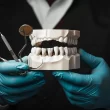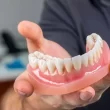Beyond being one of the best innovations in Dentistry, dental implants are unarguably one of the best options for long-term tooth replacement.
While the different types of dental implants have varying degrees of safety and effectiveness in specific situations, they’re generally safe and helpful. Your dental professional can help determine if you require any of the four dental implant procedures.
Here’s an exposition about dental implants, the 4 types of dental implants, and how to know which one is right for you.
Also Read: Top 5 Dental Insurance That Covers Invisalign
What are Dental Implants?
A dental implant is a prosthetic tooth surgically placed into a patient’s jawbone to support a replacement tooth. Unlike conventional dentures or dental bridges, dental implants are designed to fuse into your jawbone, offering a stable and durable foundation for your new teeth. Most dental implants are made of Titanium, while a smaller category of others are made of ceramic, polymer, and Zirconium.
The four main types of dental implants have unique benefits and considerations. They include endosteal implants, subperiosteal implants, zygomatic implants, and the all-on-4 implants.
Endosteal implants are the most commonly used and the safest, while all-on-4 dental implants are the most expensive. A patient’s oral health and measure of bone density ultimately determine the right type of dental implant they may require.
While the potential risks and complications can vary for each dental implant type, the most common threats are the risks of infection and implant failure. But this is no cause for worry, as your dentist can perform the necessary precautions to avoid such risks.
4 Types of Dental Implants
Each dental implant type comes in different sizes and structures, partly depending on the dental patient’s profile. Next, we consider the four various types of dental implants in detail, plus how to know which might be the best option for you.
1. Endosteal Implants
Endosteal implants are the most common and preferred dental implant type. That’s because of their high success rate and durability. They typically consist of a Titanium post that is surgically embedded directly into the jawbone to mimic a natural root tooth.
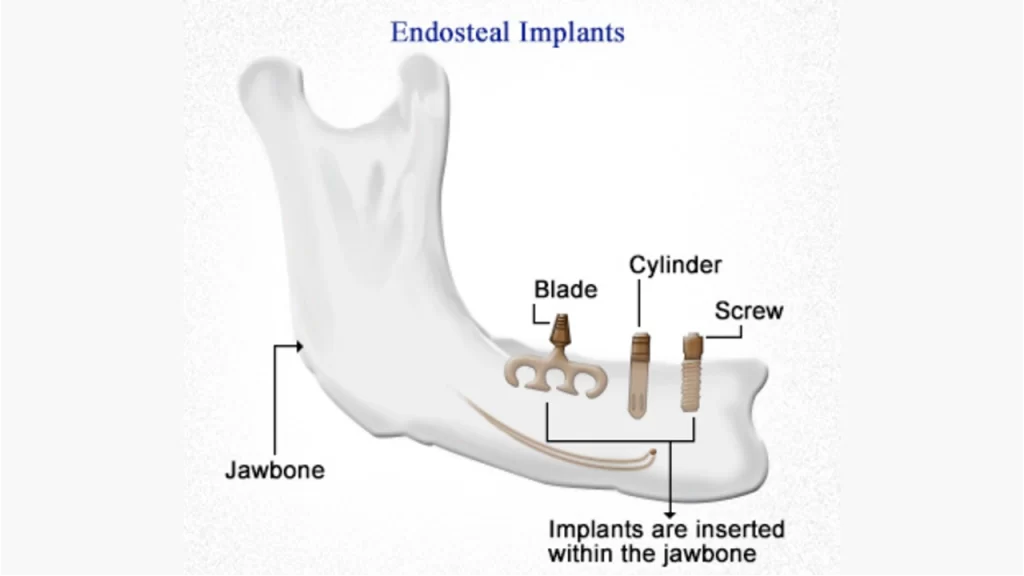
After some time, the implant fuses with the surrounding bone via a process called osseointegration, setting up a strong, stable foundation for the replacement tooth. Endosteal implants differ from other dental implant types in that they’re placed directly inside the jawbone. The procedure typically involves multiple steps.
First, the dentist surgically places the implant in the jawbone, while the patient waits out several months to heal. During the expected healing period, the implant integrates with the bone via an abutment (connector). Finally, the dentist places a customized dental crown on top, seamlessly blending with the rest of the teeth.
Also Read: What is a Dental Flipper? Know This Before Getting One
Endosteal implants are best for patients with strong and healthy jawbones and require single-tooth replacements or multiple implants. Besides their high success rate and durability, endosteal implants are preferred because they are naturally looking and promote jawbone health.
2. Subperiosteal Implants
Subperiosteal implants are excellent options for patients who lack the requisite jawbone density for endosteal implants and cannot or do not want a bone graft. While endosteal implants are directly grafted into the jawbone, subperiosteal implants sit on top of the bone beneath the gum tissue.
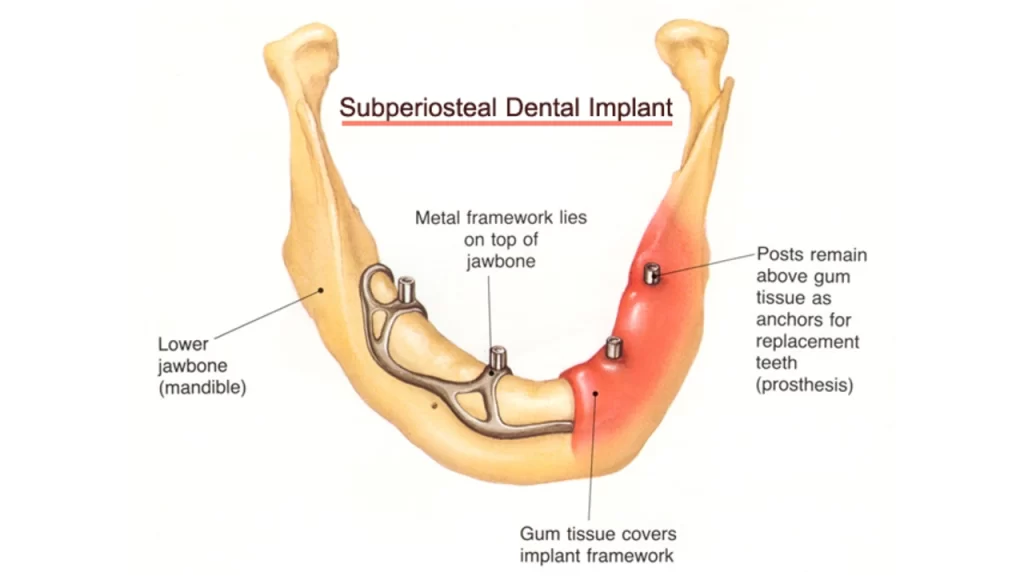
Instead, a custom metal lies beneath the gums, with small posts protruding via the tissue to support the artificial teeth. Because subperiosteal implants do not integrate with the bones in the same way as an endosteal implant, they’re less stable than the latter. However, it still offers a secure, functional replacement option for lost teeth.
Healthcare professionals recommend this implant type for patients who need a full arch restoration but do not have sufficient bone mass to support conventional implants. On the upside, this procedure is less invasive than endosteal implants, making it a viable option for older adults or people with other health conditions that may complicate a more extensive surgery.
3. “Teeth in a Day” or All-on-4 Dental Implants
All-on-4 dental implants are recommended for patients missing most or all of their teeth. They offer full-arch restoration using only four strategically placed implants per jaw. With this innovative technique, a patient won’t need an implant for every missing tooth. Consequently, it costs less money and treatment time.

The procedure involves placing two implants at an angle toward the back and another pair toward the front of the jaw. With this angled placement, patients with some bone loss can get implants without requiring a bone graft.
To do this, the dentist will put four implants in available bone before adding special abutments that can hold the same-day temporary replacement teeth. Once the implants are placed, a full set of replacement teeth is attached, often on the same day, giving it the name “teeth in a day.”
After the surgical procedure, you’ll have to wait about 6 months for your gum tissues to heal and the implants to bond with your natural bone tissues. Moreover, your dentist will recommend a special diet to assist in the healing process.
With all-on-4 implants, patients can regain full chewing abilities and aesthetic appeal, making them a notable choice for patients who want a more permanent option over dentures. However, this implant type requires commitment to proper oral hygiene and regular medical check-ups to ensure long-term success. Finally, it’s worth noting that this procedure requires healthy gums and sufficient bone for support, and could require replacement prosthetic teeth over time.
4. Zygomatic Implants
This category of implant replaces missing teeth in patients with significant bone loss in the upper jaw. They are anchored into the cheekbone (zygomatic bone), which is denser than the maxillary bone.
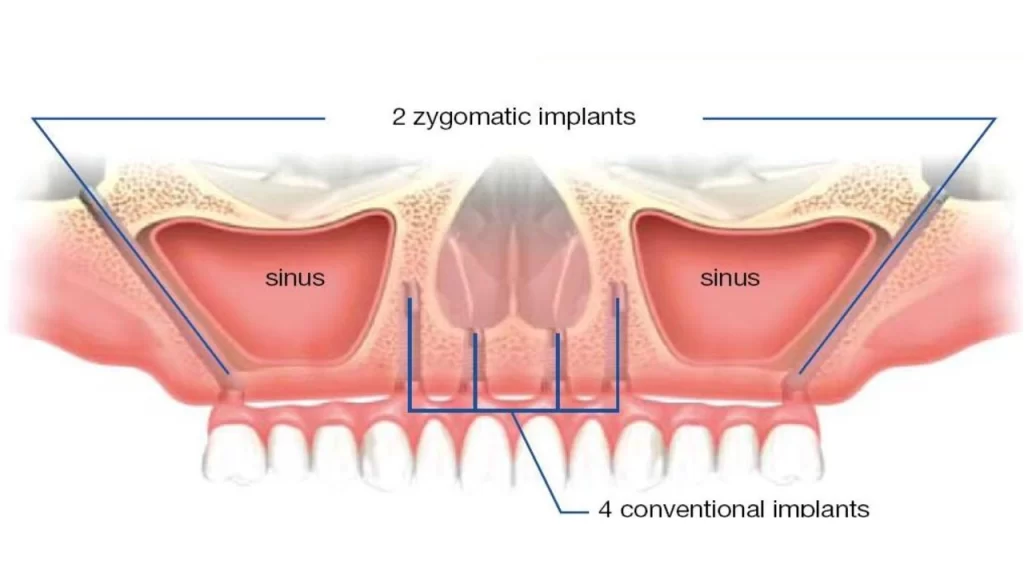
As a result, zygomatic implants can provide a more stable foundation for the implant. Unlike conventional implants, these implants allow for a graftless solution, avoiding bone grafting and sinus lift procedures. They also involve less treatment time because they avoid bone grafting and sinus lift. During the procedure, one or two zygomatic implants are placed on each side of the dental arch, creating a secure foundation for the upper arch bridge to be placed.
Also Read: Best Dental Insurance in Utah
Factors to Consider When Choosing a Dental Implant
With the right information, it’s relatively easier to make an informed decision when choosing a dental implant. Your dental health professional could also recommend a dental implant type based on their needs, dental function, and overall quality of life. Here are other factors to consider when choosing a dental implant.
- Bone density: It’s vital to consider bone quality because dental implants require strong and sufficient bone structures to adhere to. Bone loss can increase the risk of poor osseointegration, which can hinder the success rate of dental implants. Dentists engage in advanced dental technology in assessing the condition of a patient’s cheekbones or jawbone.
- Lifestyle factors: Considering lifestyle choices is vital before choosing a dental implant. For instance, habits like smoking can increase the risk of dental implant failure.
- Aesthetic considerations: Dental professionals also consider how dental prosthetics could look in the final outcome. They evaluate regions surrounding the implant to give you the most beautiful smile.
- Oral health: Patients’ gums and bones must be healthy for artificial teeth to function properly. Poor oral health could hinder the healing process and cause problems in the future. If there are existing oral health conditions, such as gum disease, the dentist will consider them before recommending a treatment option.
Conclusion
Endosteal is the most common type of dental implant and the safest. Subperiosteal implants come next after endosteal implants in popularity, while zygomatic dental implants can be the most complicated. A “teeth-in-a-day” implant could be the best option for individuals who have lost most or all of their teeth. With the information here, you can safely make an informed decision about choosing a dental implant so you can smile as beautifully as ever.


